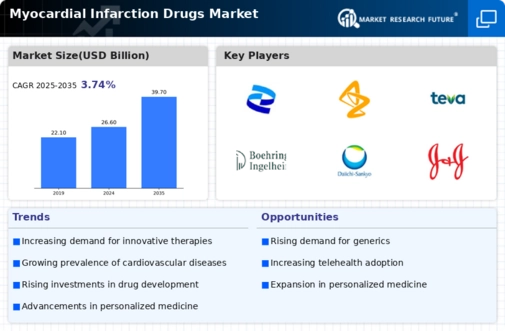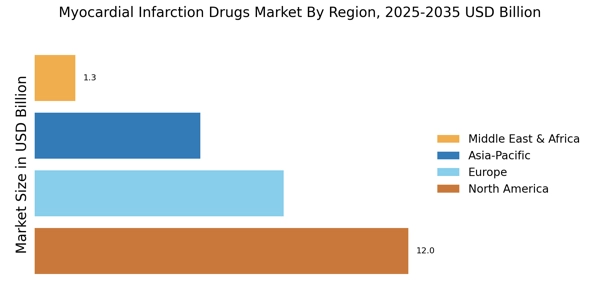Advancements in Drug Development
Innovations in drug development methodologies are significantly influencing the Myocardial Infarction Drugs Market. The advent of novel therapeutic agents, including antiplatelet drugs and thrombolytics, has transformed treatment protocols for myocardial infarction. Recent advancements in biotechnology and pharmacogenomics have enabled the creation of targeted therapies that enhance efficacy and minimize side effects. For instance, the introduction of dual antiplatelet therapy has shown to improve patient outcomes post-myocardial infarction. As research continues to evolve, the pipeline for new drugs remains robust, with numerous candidates undergoing clinical trials. This dynamic environment suggests a promising future for the market, as new entrants may offer improved treatment options and address unmet medical needs.
Regulatory Support for Drug Approvals
Regulatory bodies are playing a pivotal role in shaping the Myocardial Infarction Drugs Market through streamlined approval processes for new medications. Recent initiatives aimed at expediting the review and approval of innovative therapies are likely to enhance market dynamics. For instance, fast-track designations and priority review vouchers are being utilized to bring effective myocardial infarction drugs to market more swiftly. This regulatory support not only encourages pharmaceutical companies to invest in research and development but also ensures that patients have timely access to new treatment options. As a result, the market may witness an influx of novel drugs that address various aspects of myocardial infarction management, ultimately benefiting patient outcomes.
Rising Awareness and Education on Heart Health
The growing emphasis on heart health education is significantly impacting the Myocardial Infarction Drugs Market. Public health campaigns aimed at raising awareness about the risk factors and symptoms of myocardial infarction are becoming more prevalent. These initiatives encourage individuals to seek medical attention promptly, leading to earlier diagnosis and treatment. As awareness increases, so does the demand for effective myocardial infarction drugs, as patients become more informed about their treatment options. Additionally, healthcare professionals are increasingly focusing on educating patients about lifestyle modifications and adherence to prescribed therapies, which may further drive the market as patients seek to manage their cardiovascular health proactively.
Growing Investment in Healthcare Infrastructure
The expansion of healthcare infrastructure is a crucial factor driving the Myocardial Infarction Drugs Market. Governments and private entities are increasingly investing in healthcare facilities, technology, and services to enhance patient care. This investment is particularly evident in regions with high rates of myocardial infarction, where improved access to healthcare services can lead to better management of cardiovascular diseases. Enhanced infrastructure facilitates timely diagnosis and treatment, which is essential for myocardial infarction patients. Moreover, the establishment of specialized cardiac care units and advanced diagnostic tools is likely to increase the demand for myocardial infarction drugs, as healthcare providers seek to optimize treatment outcomes for their patients.
Increasing Prevalence of Cardiovascular Diseases
The rising incidence of cardiovascular diseases, particularly myocardial infarction, is a primary driver of the Myocardial Infarction Drugs Market. As lifestyle-related factors such as obesity, sedentary behavior, and unhealthy diets become more prevalent, the demand for effective treatment options escalates. According to recent statistics, cardiovascular diseases account for a substantial percentage of global mortality, prompting healthcare systems to prioritize interventions. This trend is likely to fuel the development and commercialization of innovative myocardial infarction drugs, as pharmaceutical companies seek to address the growing patient population. Furthermore, the increasing awareness of heart health among the public may lead to earlier diagnosis and treatment, further propelling market growth.


















Leave a Comment